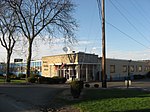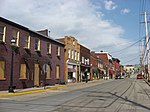Matthew S. Quay House
Death care companies of the United StatesHouses in Beaver County, PennsylvaniaHouses on the National Register of Historic Places in PennsylvaniaIndividually listed contributing properties to historic districts on the National Register in PennsylvaniaNRHP infobox with nocat ... and 3 more
National Historic Landmarks in PennsylvaniaNational Register of Historic Places in Beaver County, PennsylvaniaUse mdy dates from August 2023

The Matthew S. Quay House is a historic house at 205 College Avenue in Beaver, Pennsylvania. Built sometime after the American Civil War, it was from 1874 until his death the home of Matthew Stanley Quay (1833–1904), a United States senator and one of the most influential political party bosses of the late 19th century. His house was declared a National Historic Landmark in 1975. It was the location of the J.T. Anderson Funeral Home. However, now it is home to Covenant Financial Advisors.[1]
Excerpt from the Wikipedia article Matthew S. Quay House (License: CC BY-SA 3.0, Authors, Images).Matthew S. Quay House
College Avenue,
Geographical coordinates (GPS) Address Nearby Places Show on map
Geographical coordinates (GPS)
| Latitude | Longitude |
|---|---|
| N 40.693611111111 ° | E -80.304166666667 ° |
Address
College Avenue
15009
Pennsylvania, United States
Open on Google Maps








